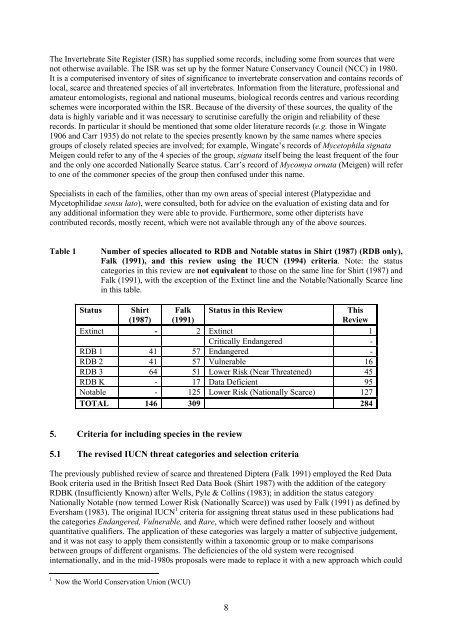Part 2: Nematocera and Aschiza not dealt with by Falk (1991) - JNCC
Part 2: Nematocera and Aschiza not dealt with by Falk (1991) - JNCC
Part 2: Nematocera and Aschiza not dealt with by Falk (1991) - JNCC
You also want an ePaper? Increase the reach of your titles
YUMPU automatically turns print PDFs into web optimized ePapers that Google loves.
The Invertebrate Site Register (ISR) has supplied some records, including some from sources that were<br />
<strong>not</strong> otherwise available. The ISR was set up <strong>by</strong> the former Nature Conservancy Council (NCC) in 1980.<br />
It is a computerised inventory of sites of significance to invertebrate conservation <strong>and</strong> contains records of<br />
local, scarce <strong>and</strong> threatened species of all invertebrates. Information from the literature, professional <strong>and</strong><br />
amateur entomologists, regional <strong>and</strong> national museums, biological records centres <strong>and</strong> various recording<br />
schemes were incorporated <strong>with</strong>in the ISR. Because of the diversity of these sources, the quality of the<br />
data is highly variable <strong>and</strong> it was necessary to scrutinise carefully the origin <strong>and</strong> reliability of these<br />
records. In particular it should be mentioned that some older literature records (e.g. those in Wingate<br />
1906 <strong>and</strong> Carr 1935) do <strong>not</strong> relate to the species presently known <strong>by</strong> the same names where species<br />
groups of closely related species are involved; for example, Wingate’s records of Mycetophila signata<br />
Meigen could refer to any of the 4 species of the group, signata itself being the least frequent of the four<br />
<strong>and</strong> the only one accorded Nationally Scarce status. Carr’s record of Mycomya ornata (Meigen) will refer<br />
to one of the commoner species of the group then confused under this name.<br />
Specialists in each of the families, other than my own areas of special interest (Platypezidae <strong>and</strong><br />
Mycetophilidae sensu lato), were consulted, both for advice on the evaluation of existing data <strong>and</strong> for<br />
any additional information they were able to provide. Furthermore, some other dipterists have<br />
contributed records, mostly recent, which were <strong>not</strong> available through any of the above sources.<br />
Table 1<br />
Number of species allocated to RDB <strong>and</strong> Notable status in Shirt (1987) (RDB only),<br />
<strong>Falk</strong> (<strong>1991</strong>), <strong>and</strong> this review using the IUCN (1994) criteria. Note: the status<br />
categories in this review are <strong>not</strong> equivalent to those on the same line for Shirt (1987) <strong>and</strong><br />
<strong>Falk</strong> (<strong>1991</strong>), <strong>with</strong> the exception of the Extinct line <strong>and</strong> the Notable/Nationally Scarce line<br />
in this table.<br />
Status Shirt<br />
(1987)<br />
<strong>Falk</strong><br />
(<strong>1991</strong>)<br />
Status in this Review<br />
This<br />
Review<br />
Extinct - 2 Extinct 1<br />
Critically Endangered -<br />
RDB 1 41 57 Endangered -<br />
RDB 2 41 57 Vulnerable 16<br />
RDB 3 64 51 Lower Risk (Near Threatened) 45<br />
RDB K - 17 Data Deficient 95<br />
Notable - 125 Lower Risk (Nationally Scarce) 127<br />
TOTAL 146 309 284<br />
5. Criteria for including species in the review<br />
5.1 The revised IUCN threat categories <strong>and</strong> selection criteria<br />
The previously published review of scarce <strong>and</strong> threatened Diptera (<strong>Falk</strong> <strong>1991</strong>) employed the Red Data<br />
Book criteria used in the British Insect Red Data Book (Shirt 1987) <strong>with</strong> the addition of the category<br />
RDBK (Insufficiently Known) after Wells, Pyle & Collins (1983); in addition the status category<br />
Nationally Notable (now termed Lower Risk (Nationally Scarce)) was used <strong>by</strong> <strong>Falk</strong> (<strong>1991</strong>) as defined <strong>by</strong><br />
Eversham (1983). The original IUCN 1 criteria for assigning threat status used in these publications had<br />
the categories Endangered, Vulnerable, <strong>and</strong> Rare, which were defined rather loosely <strong>and</strong> <strong>with</strong>out<br />
quantitative qualifiers. The application of these categories was largely a matter of subjective judgement,<br />
<strong>and</strong> it was <strong>not</strong> easy to apply them consistently <strong>with</strong>in a taxonomic group or to make comparisons<br />
between groups of different organisms. The deficiencies of the old system were recognised<br />
internationally, <strong>and</strong> in the mid-1980s proposals were made to replace it <strong>with</strong> a new approach which could<br />
1 Now the World Conservation Union (WCU)<br />
8
















